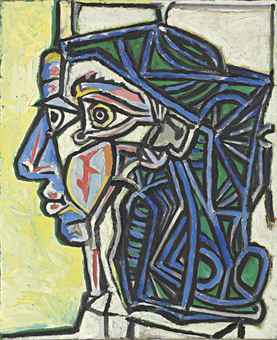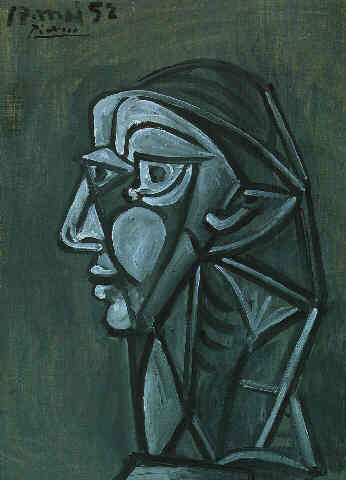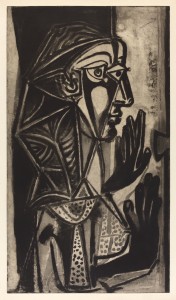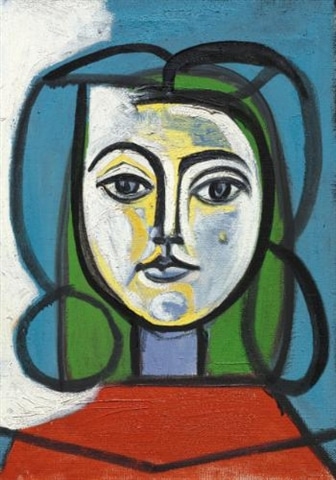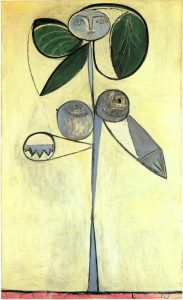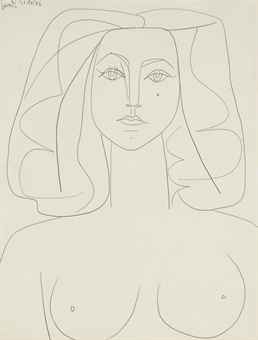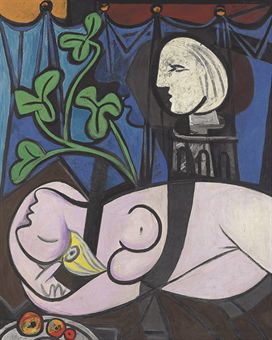There are a number of lovely Picasso paintings and works on paper in NY this season, but the one that stands out the most is the above oil painting of Françoise at Christie’s. Although Picasso created quite a number of beautiful drawings and prints of his new lover, his paintings of her were generally not among his best. Tête de femme (1952) is that much more remarkable, because it certainly ranks as one of the finest paintings of Françoise, arguably one of the two best. The other one, La femme-fleur (The Woman-Flower), is in the subject’s private collection. (In the end, it seems Françoise didn’t fare that badly….)
Picasso must have been pleased with this painting. The day before he had painted this smaller oil:
…and he must have known he was on to something. Then he refined his thoughts with the painting at hand, and also made this style du jour more widely available by recreating it in a large aquatint format, La Femme a la Fenêtre, one of his very finest prints, in an edition of 73:
Another beautiful portrait of Françoise was featured last May at Sotheby’s with the same estimate as the current lot, $4-6M:
At 55 cm, it was a bit bigger, and it sold for just over the high estimate.
The only argument that can explain the ridiculously low estimate for the current offering, other than the sellers’ desire to engender a feeding frenzy, is its comparatively small size (45.7 cm). But the painting is limited to the woman’s head, and this head is at least as large as any of her best portraits. Still, for those who don’t grade art like real estate–that is, in terms of size, this painting should soar much higher, easily triple the high estimate.
This smallish painting is reminiscent of the even smaller but at least as wonderful Marie-Thérèse oil that I blogged about last season. At just under $10M, that one went above the high estimate, but not nearly what I think it’s worth. In that case, size and simplicity worked in favor of the buyer. In the present case, simplicity should no longer be a mitigating factor in anyone’s eyes (it never is in mine), but we’ll see what happens this time with respect to size.
Before we leave the subject of paintings, for those of you who may be unacquainted with La femme-fleur, the most important portrait of Françoise bar none, here’s a photo:
If you’re not quite in the above price bracket, there’s also a lovely contour drawing of this muse, well-priced and full size, at Christie’s the very next day (estimate $3-400K):
For those of us for whom price is really no object, in the Sotheby’s evening sale there is this serene masterpiece:
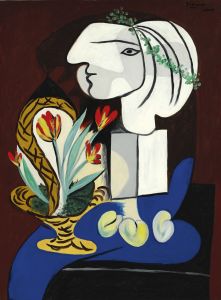
Nature morte aux tulips (1932)
It is from the same celebrated year, 1932, as the current Picasso auction record ($106.5M):
Though the painting at hand is estimated at $35-50M, it is only a bit smaller (130 cm vs. 162 cm) than the reigning Marie-Thérèse and is, in my opinion, at least as wonderful. (Frankly, in my mind there is no contest.) There’s so much that can be said about this painting, but for now I just want to call attention to his speed. It is well-known that Picasso was a lightning-fast artist. But this is the only instance of which I’m aware in which he recorded the time it took for him to paint a given work. The stretcher, according to the Sotheby’s, is inscribed “H 9 à 11 1/2 Hs”, that is, 9 AM to 11:30 AM. Picasso had apparently impressed himself, not to mention the rest of us.
